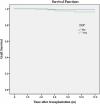Predictors and one-year outcomes of patients with delayed graft function after deceased donor kidney transplantation
- PMID: 33276737
- PMCID: PMC7716446
- DOI: 10.1186/s12882-020-02181-1
Predictors and one-year outcomes of patients with delayed graft function after deceased donor kidney transplantation
Abstract
Background: Delayed graft function (DGF) is closely associated with the use of marginal donated kidneys due to deficits during transplantation and in recipients. We aimed to predict the incidence of DGF and evaluate its effect on graft survival.
Methods: This retrospective study on kidney transplantation was conducted from January 1, 2018, to December 31, 2019, at the Second Xiangya Hospital of Central South University. We classified recipients whose operations were performed in different years into training and validation cohorts and used data from the training cohort to analyze predictors of DGF. A nomogram was then constructed to predict the likelihood of DGF based on these predictors.
Results: The incidence rate of DGF was 16.92%. Binary logistic regression analysis showed correlations between the incidence of DGF and cold ischemic time (CIT), warm ischemic time (WIT), terminal serum creatine (Scr) concentration, duration of pretransplant dialysis, primary cause of donor death, and usage of LifePort. The internal accuracy of the nomogram was 83.12%. One-year graft survival rates were 93.59 and 99.74%, respectively, for the groups with and without DGF (P < 0.05).
Conclusion: The nomogram established in this study showed good accuracy in predicting DGF after deceased donor kidney transplantation; additionally, DGF decreased one-year graft survival.
Keywords: Deceased donation; Delayed graft function; Graft survival; Nomogram; Predictors.
Conflict of interest statement
None.
Figures




References
-
- Shoskes DA, Cecka JM. Deleterious effects of delayed graft function in cadaveric renal transplant recipients independent of acute rejection. Transplantation. 1998;66(12):1697–1701. - PubMed
-
- Irish WD, McCollum DA, Tesi RJ, Owen AB, Brennan DC, Bailly JE, Schnitzler MA. Nomogram for predicting the likelihood of delayed graft function in adult cadaveric renal transplant recipients. J Am Soc Nephrol. 2003;14(11):2967–2974. - PubMed
-
- Geddes CC, Woo YM, Jardine AG. The impact of delayed graft function on the long-term outcome of renal transplantation. J Nephrol. 2002;15(1):17–21. - PubMed
Publication types
MeSH terms
Substances
LinkOut - more resources
Full Text Sources
Medical

